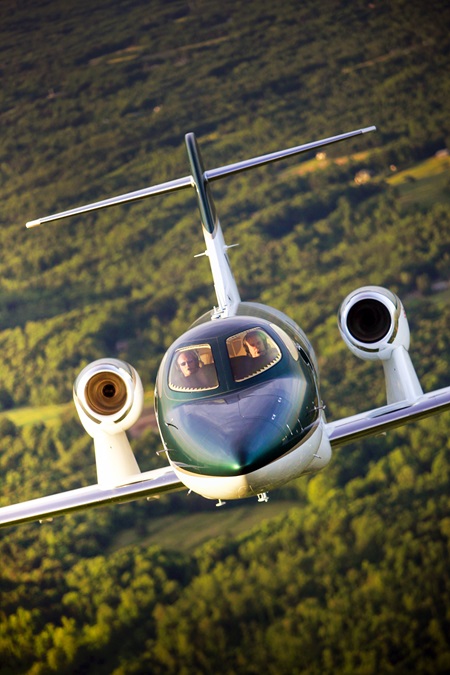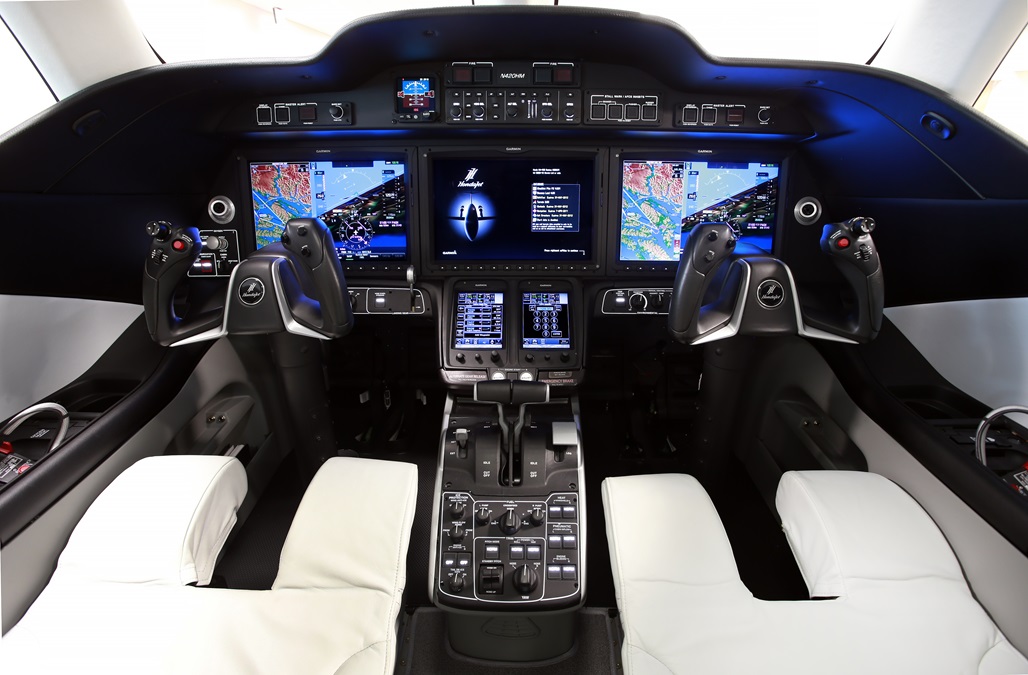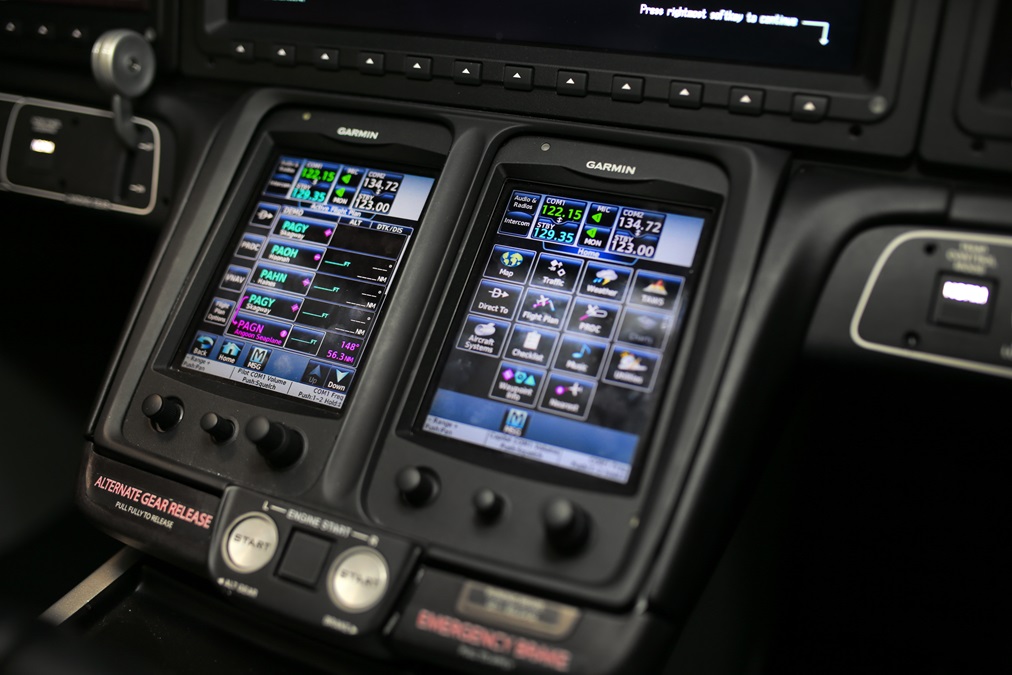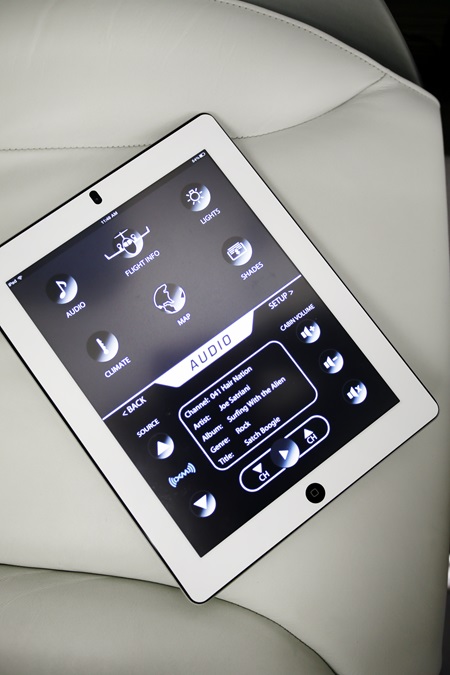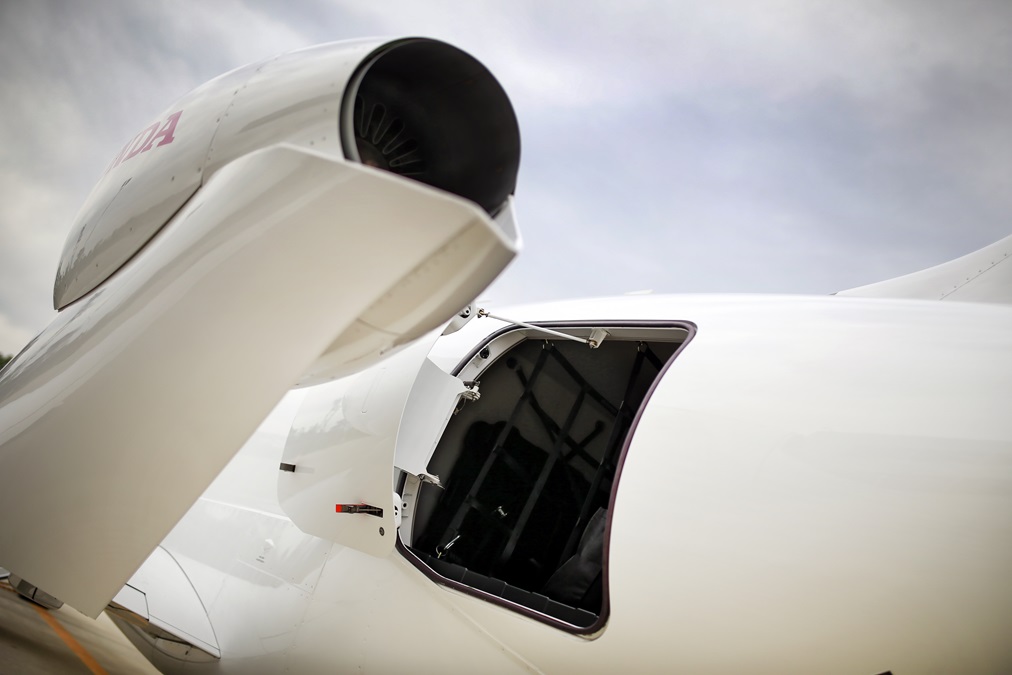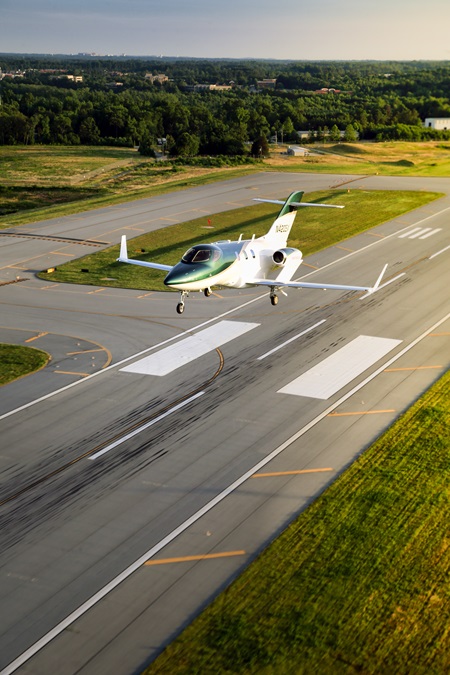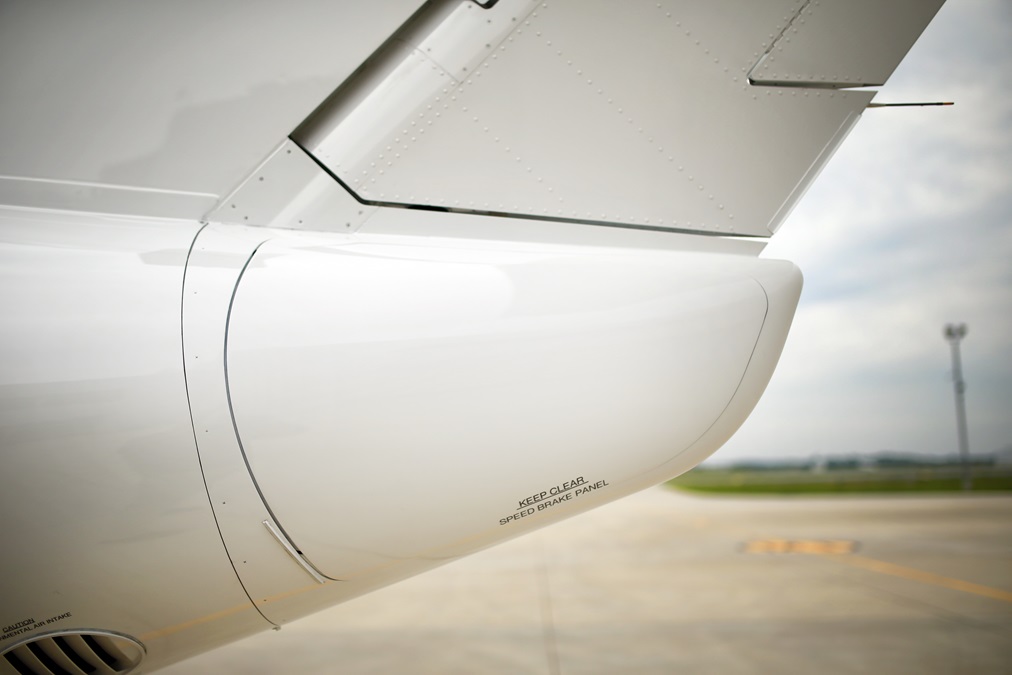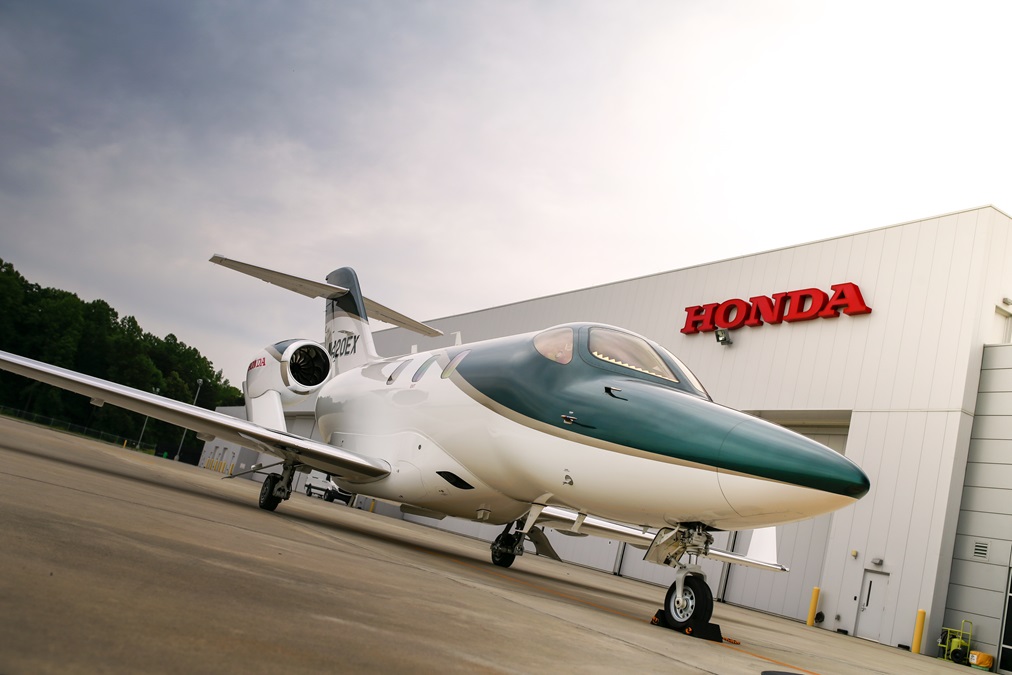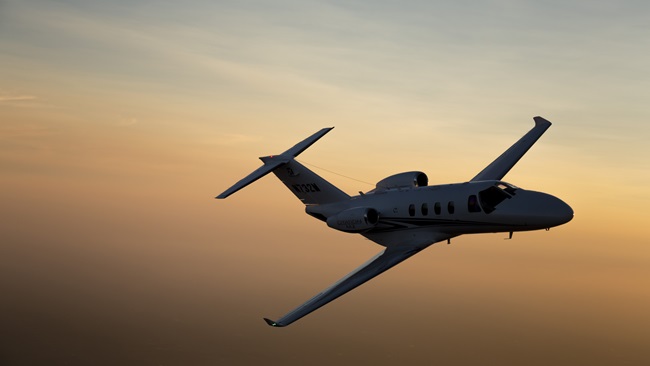A Matter of Speed
The HondaJet delivers performance across the spectrum
Through it all, Fujino soldiered on, delivering on his dream of a more efficient design. While today’s airplane looks remarkably like the 2005 proof of concept, there are subtle differences—a few airflow strips on the surfaces and vortex generators on the winglets, for example. Not surprisingly, the max takeoff weight was increased from 9,200 pounds to 10,600, providing for a little more fuel—up by 545 pounds to 2,845, but resulting in an IFR range about 100 nautical miles farther than originally estimated. Of course, to handle the extra weight and to therefore meet (or in this case, beat) the top speed demands, the engine thrust has been increased from 1,670 pounds to 2,050 pounds—the sort of circular performance changes necessary as weight increases during the certification process.
With typical cruise fuel burns of only around 610 pounds per hour total (about 91 gallons)—lower than most others in the category—the HondaJet also meets Fujino’s efficiency goals. Part of that efficiency comes from the completely new engines, designed as a partnership between Honda and GE and built just down the road in Burlington, North Carolina. The balance of the efficiency comes from the aerodynamic design. The HondaJet’s unusually shaped honeycomb composite cockpit area provides for natural laminar flow, reducing drag. Similarly, the aluminum wings provide a high degree of natural laminar flow. Most radical, though, are the over-the-wing engine mounts, OTWEM in Honda parlance. The wing-mounted engine pylons themselves reduce drag compared to conventional tailcone-mounted engines, according to Fujino. The byproduct of putting the engines on the wing is the ability to have a constant contour to the composite fuselage, providing for more cabin space. Honda leverages that space for more knee room, a larger aft lavatory than you’d expect in an airplane of this size (including optional running water in the basin and externally serviced potty), and a large baggage compartment in the tail. Those sitting in the club seats have more knee room than in any other similarly sized airplane. In addition to the four seats, Honda offers an optional side-facing seat opposite the door.
As well as benefiting from the latest aerodynamics, engines, and manufacturing techniques, the HondaJet also comes with fresh thinking regarding technology in the cockpit and cabin. A smartphone app allows passengers to control the window shades, temperature, and entertainment in the cabin, for example.
Up front, the Garmin G3000 with its touchscreen controllers integrates and automates most system functions. In the cockpit, a Norm setting equates to automatic. Release the parking brake and the taxi light comes on. Advance the throttle on the runway, and the pitot heat and strobe lights turn on. Wherever you are, an hour before sunset until an hour after sunrise, the navigation lights are automatically illuminated. Enter your destination in the flight plan and the landing elevation and pressurization schedule are automatically set. Don the oxygen mask and the system automatically switches to the mask microphone. The ice detection system automatically turns on the wing and tail deicing systems; the pilot must manually turn on the engine heat. They’re all small things, but important aids in a cockpit designed for single-pilot operations.
Of course, the G3000’s autopilot system also provides a great deal of assistance to the pilot, changing pitch to prevent over- and underspeeds. Even if not engaged, the flight control system tries to nudge the pilot back to safety when straying too close to the edge of the envelope. Ultimately a stick shaker and then stick pusher will prevent a stall. In the case of a depressurization, which might result in pilot incapacitation, the system will turn the airplane 90 degrees to exit an airway and descend to 15,000 feet, where it will level off.
While the automation is helpful, it doesn’t take away from the fun of flying this new airplane. Thanks to the modern design, cockpit set-up is quick, as Honda demo pilot Tim Frazier demonstrates from the right seat. Digital checklists appear on the multifunction display, managed through a yoke-mounted scroll wheel. Surprisingly, one area where automation has not yet caught up is determining V speeds. Similarly equipped airplanes will automatically calculate the V speeds for takeoff and landing and share them with the flight management system for display on the primary flight display. That feature is a software update away, according to Frazier. Today we look them up and manually enter them.
Engine starts, monitored by the full-authority digital engine controls (FADEC), are a simple touch of a button, and we’re ready to taxi. Frazier suggests we make a couple of circles on the ramp to get me used to the nose gear steering system, which is electrically controlled and hydraulically actuated. That, combined with the electrically controlled brakes, makes for some jerky movements right out of the box. However, by the time we’ve made a circle on the ramp and taxied to the runway, I’ve mostly mastered the nuances—and our photographers in the back are no longer bouncing their heads off the sidewalls.
With four on board, we weigh 10,300 pounds, about 300 pounds below max takeoff. Our balanced field length is 3,300 feet. Hand flying up to 29,000 feet, I find the HondaJet pleasurable and predictable. Thanks to FAA certification standards, jets in this category will handle quite similarly. This one is balanced nicely. Leveling off at FL430, our speed after a few minutes settles at about 365 KTAS burning 610 pounds an hour total. Like other jets, the max speed of 422 KTAS will occur only in the mid-30s, where almost no one flies a business jet. Fuel burn there will increase by more than 50 percent, providing owners a real incentive to go higher—not to mention the ability to get more direct routings and stay above almost all of the weather.
The fun begins when we practice an emergency descent, slamming the thrust levers back, speed brakes (an option) deployed, roll into a turn, and push the nose over to more than 10 degrees down. Like some fighters, the speed brakes are a clamshell design on the tail, as opposed to the more traditional wing-mounted brakes. There is very little bump when the brakes are deployed and no limit on airspeed. “They don’t startle the passengers,” says Frazier. With the North Carolina countryside filling the windscreen, we soon level off at FL240 and then continue a more gradual descent to 11,000 feet to check out some maneuvers. But first I try out the cruise speed control. Dial a speed into the autopilot and the FADEC will modulate fuel flow to maintain the speed. It’s not quite autothrottles, but you can see them from there.
With thrust pulled back and holding altitude, I soon feel the stick shaker alert me that we’re straying into the stall zone. I ignore it and soon the pusher takes charge, pushing the nose over to maintain flying speed. The pusher is unusual but not unheard of in light jets. Frazier says it is an aid to single pilots, not a device to mask any bad manners in a full stall.
Anyone who has flown a Garmin GTN 750 will be comfortable loading a procedure in the FMS; the navigation pages are nearly identical. We choose an ILS to Runway 23L at Greensboro. I hand-fly the final segment. Trimmed up, the airplane is remarkably stable. Crossing the fence, I’m slowing through the VREF of 108 KIAS and touch down very gently, if I do say so myself. Frazier resets the flaps and I add the thrust for a touch and go, reminding myself about the touchy nose gear steering. The thrust takes a second to kick in but when it does, I’m pressed into the seat.
“That was really good,” says Frazier, as surprised as I am. “Beginner’s luck,” I deflect, really feeling the pressure now for the second one. A normal pattern yields another really nice touchdown and more congratulations from Frazier as we do another touch and go. The third one, a full stop, is just as nice. I’m usually my own worst critic, especially regarding landings. But they were three good ones. I’d like to think it’s some exceptional talent on my part, but I know the reality is that the Honda wing and the trailing-link landing gear simply make for nice landings.
My toes find the sweet spot quickly and we’re taxiing back to the Honda ramp without any jerkiness.
Not surprisingly, Honda—a company with a global reputation for quality across its broad product line—has built a fine airplane that can compete well in the category. The company claims an order book of more than 100 and has plans to deliver some 40 aircraft this year and 60 next year.
Its challenges are those facing any new entrant: established competition that can afford to undercut it in pricing, which Cessna has certainly been doing with the M2; building a service, parts, and training network that meets the needs of today’s demanding customers; and building brand loyalty for the next Honda aircraft—again something Cessna has in spades and Embraer is beginning to develop.
Fortunately, Honda is at least a well-known brand, if not in the airplane business.
The light jet market these past few years has been soft. Cessna and Embraer have airplanes available now. Those just now placing an order for a HondaJet are going to wait years, in most cases.
On the other hand, Honda is one of the largest companies in the world, so it certainly has the staying power. And, given the campus Honda built in Greensboro, it’s clear the Model HA-420 isn’t the only model we can expect from the company. Fujino, of course, won’t confirm anything, but after years of being asked “will there be a family of airplanes?” he replied recently with a smile and a polite nod, “I like family.” Stay tuned.
Email [email protected]
SPEC SHEET
HondaJet HA-420
Base price: $4.85 million
Price as tested: $5 million
Specifications
Powerplants | 2 GE Honda Aero HF120, 2,095 lbst derated to 2,050 lbst
Recommended TBO | 5,000 hr
Length | 46 ft 6 in
Height | 14 ft 9 in
Wingspan | 39 ft 8 in
Wing area | 176.6 sq ft
Wing loading | 60 lb/sq ft
Power loading | 2.6 lb/lbst
Seats | 1+5/6
Cabin length | 12 ft 1 in
Cabin width | 5 ft
Cabin height | 4 ft 8.3 in
Basic operating weight | 7,279 lb
Maximum ramp weight | 10,680 lb
Maximum takeoff weight | 10,600 lb
Zero fuel weight | 8,800 lb
Max payload | 1,521 lb
Fuel with max payload | 1,880 lb
Useful load | 3,401 lb
Payload w/max fuel | 551 lb
Maximum landing weight | 9,860 lb
Fuel capacity | 2,850 lb, 425 gal
Baggage capacity, nose | 100 lb, 9 cu ft
Aft | 400 lb, 57 cu ft
Performance
Maximum cruise speed, FL310 | 422 KTAS
High-speed cruise, FL310 | 422 KTAS, 1,110 lb/hour total
Long-range cruise, FL430 | 368 KTAS/607 lb/hour total
Range (1 pilot + 3 pax, NBAA IFR reserves) | 1,206 nm
Maximum operating altitude | 43,000 ft
Sea-level cabin | 23,000 ft
Landing distance | 3,678 ft
Limiting and recommended airspeeds
V1 (takeoff decision speed) | 110 KIAS
VR (rotation) | 115 KIAS
V2 (takeoff safety speed) | 120 KIAS
VFE (max flap extension)
Takeoff/approach | 200 KIAS
Landing | 160 KIAS
VLE (max gear extended) | 200 KIAS
VLO (max gear operating)
Extend | 200 KIAS
Retract | 200 KIAS
VREF (reference speed, final approach) | 112 KIAS
VMO (max operating speed) at FL302 | 270 KIAS
MMO (max Mach number) | 0.72 Mach
For more information
Honda Aircraft Company, 6430 Ballinger Road, Greensboro, North Carolina 27410; 888-453-5937; www.hondajet.com
All specifications are based on manufacturer’s calculations. All performance figures are based on standard day, standard atmosphere, sea level, gross weight conditions unless otherwise noted.

